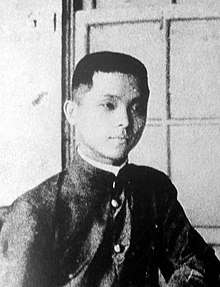Huang Tu-shui
Huang Tu-shui (Chinese: 黃土水; 1895–1930) was a pioneer of modern sculptor in Taiwan.[1] From his youth, Huang was familiar with the traditional carving of Taiwan, and was influenced by modern Western styles during his studies in Tokyo. These include the works that were included in the Japanese Imperial Exhibition of 1922, such as Mountain Child Playing Flute.[2] He also went by the names Huáng Tǔshuǐ, Pe̍h-oē-jī, Ng Thóo-Suí.
Huang Tu-shui | |
|---|---|
黃土水 | |
 | |
| Born | 3 July 1895 |
| Died | 21 December 1930 (aged 35) Japan |
| Other names | Huáng Tǔshuǐ, Pe̍h-oē-jī, Ng Thóo-Suí |
| Occupation | Sculptor |
Biography

Huang was born on 3 July 1895 in Mengjia (a.k.a. Manka), Taipei City, now known as Wanhua, and his father was a rickshaw repairman.[3] He was a student at Da Daocheng Elementary School, now called Taiping Elementary School.[2] Huang was trained in Tokyo, and later worked there, when Taiwan was part of the Japanese Empire.[4] Six months after graduating from school, he was sponsored by a Taiwan Governor-General official to study carving at the Tokyo School of Fine Arts.[3] He was the first Taiwanese student to attend the Tokyo School of Fine Arts, and also the first Taiwanese artist to be participate in the Imperial Art Exhibition of Japan (帝展, Teiten).[5]
During the last decade of his life, the focus of his works shifted more and more to local Taiwanese motifs, with Huang showing a particular taste for depicting water buffalo, a symbol of rural Taiwan. These works blended modern Western style with traditional Chinese elements. He died on 26 December 1930 in Japan, at the age of 36, after contracting peritonitis.[2][6]
Huang is best known for his mural South Land, also known as Water Buffalo, which was completed just before his death. The work is on permanent display at Zhongshan Hall in Taipei, and Taiwanese writer Zhang zhao Xuan has described it as 'a national treasure'.[7]
Selected works
- Li Tieguai (李鐵拐; Lǐ Tiěguǎi, 1915), wooden figure depicting the Li Tieguai, one of the Eight Immortals in the Daoist religion.
- The Chubby Playing Boy (山童吹笛; Shāntóng Chuī Guǎi, 1918), plaster figure, original lost today. Recorded in the 1920 Imperial Exhibition.[8]
- Sweet Dew (甘露水; Gān Lùshuǐ, 1919), marble figure, original lost today. Recorded in the imperial exhibition in 1921.[9]
- Bust of a Girl (女孩胸像; Nǚhái Xiōngxiàng, 1920), gift of the artist to his old elementary school (Taiping Elementary School in Taipei).[10]
- Posing Woman (擺姿勢的女人; Bǎi Zīshì de Nǚrén, 1922), original lost today. Recorded in the 1922 Imperial Exhibition.
- Mikadofasan and Sikahirsch (帝雉, 華鹿; Dìzhì Huálù, 1922), a gift to the Japanese imperial house, now in the imperial court office of Tokyo.
- In the Country (郊外; Jiāowài, 1924), bronze sculpture of a water buffalo with two herons, original lost today. Recorded in the 1924 Imperial Exhibition.
- In the South (南國的風情; Nánguó de Fēngqíng, 1927). Relief of a water buffalo herd, original lost today.
- The Buddha Comes from the Mountains (釋迦出山; Shìjiā Chū Shān, 1927). Commissioned on behalf of Taipei's Lungshan Temple, a wooden sculpture representing Gautama Buddha. Destroyed by an air raid during World War II, later reconstructed using a remaining plaster design. Copies can be also found in the Taipei Fine Arts Museum, the Taipei National History Museum, the Kaohsiung Museum of Fine Arts, Taipei's Lungshan Temple, Tainan's Kaiyuan Temple, and with the artist's family.
- Busy Portrait of Prince Kuni Kuniyoshi and His Wife (邇宮邦彥親王夫婦像; Ĕr Gōng Bāngyàn Fūfù Xiàng, 1928). Owned by the Japanese emperor.
- The Water Buffalo (水牛群像; Shuǐniú Qúnxiàng, 1930). Plaster cast, last and most famous work of the artist.[2] The original is located in Taipei's Zhongshan Hall, with copies in the Taipei Fine Arts Museum and the Kaohsiung Museum of Fine Arts (bronze cast).
See also
References
- "Archived copy" (PDF). Archived from the original (PDF) on 20 December 2017. Retrieved 7 June 2017.CS1 maint: archived copy as title (link)
- "The Portrait of Water Buffalo – A Brief Introduction". Taipei Zhongshan Hall. English.zsh.gov.taipei. Retrieved 7 June 2017.
- "A Portrait of Taiwanese Figures in the Japanese Colonial Period". Digital Taiwan. Taiwan e-Learning and Digital Archives Program. 1 January 2011. Retrieved 7 June 2017.
- Michael Sullivan (3 April 2006). Modern Chinese Artists: A Biographical Dictionary. University of California Press. pp. 62–. ISBN 978-0-520-24449-8.
- Han Cheung (15 December 2019). "Taiwan in Time: A visionary of 'Formosan Art'". Taipei Times. Retrieved 15 December 2019.
- Chin, Jonathan (19 September 2015). "Sculpture exhibition held to honor artistic masters – Taipei Times". Taipei Times. Retrieved 16 September 2019.
- "【人心人術】 一生傳奇,台灣第一位雕塑家黃土水 | 想想論壇". ThinkingTaiwan.com (in Chinese). Little English Education Foundation. 17 February 2016. Retrieved 7 June 2017.
- "黃土水/水牛群像/台灣日治時代雕塑家黃土水於1930年所完成之創作,是臺灣美術史上相當知名的經典傑作之一/文建會(今文化部)公告登錄為國寶,也是目前國寶名錄中第一件年代屬於二十世紀的作品 @ 姜朝鳳宗族 :: 痞客邦 ::". 姜朝鳳宗族 (in Chinese). Jiang Taigong Temple. Retrieved 16 September 2019.
- "黃土水" [Honeydew (1919)]. Taiwan Online Art Museum (in Chinese). Retrieved 16 September 2019.
- 民間藝術綜合論壇論文集: 民間藝術保存傳習計畫綜合論壇 : 界限的穿透 (in Chinese). National Center for Traditional Arts. 2005. pp. 301–. ISBN 978-986-00-1998-8.
External links
| Wikimedia Commons has media related to Huang Tu-shui. |